In this issue:
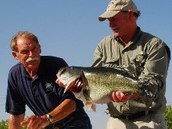
If you’re not going to eat your catch, you can release a healthy fish to the water using these five basic steps:
1. Always wet your hands before handling a fish. This will help reduce damage to the fish’s protective mucous coating that helps prevent disease and makes it glide easily in the water.
2. Use a rubber net rather than the knotted nylon type to help prevent abrasions to the fish.
3. Always use two hands to hold a fish that may weigh over 5 pounds, supporting its weight with a hand under the belly. Holding a big one only by its jaw will almost always cause injury and hinder the fish from feeding after being released. Smaller fish (< 5 pounds) can be vertically held by the lower jaw, either by hand or with grippers.
4. Gently lower your fish into the water until it begins to swim away. If it isn’t ready to swim, you may need to slowly swish it in the water first.
5. Plan ahead and take along a de-hooking tool or needle-nosed pliers to help remove the hook as quickly and safely as possible.
Check out other catch and release tips in this list. Then watch a video of a novice learning to correctly hold a big fish.
Lunkers need love too. If you plan to donate your 13-plus pound largemouth bass to the ShareLunker Program, careful handling helps keep it healthy until the TPWD pick-up takes place.
Pictured: Faron McCain, holding Toyota ShareLunker 523, O.H. Ivie Reservoir, 2011. This carefully handled fish had also been caught and entered into the program in 2010. David Campbell, also pictured, returned the fish to the lake after the spawning season.
|
Back to Top

Move over Johnny Football. Keatyn Eitelman of Pottsboro is at the top of his game too, and he’s only eleven years old. Just call him Keatyn Angler. He became Texas’ 25th Elite Freshwater Angler—and the state’s youngest—in August, just before his eleventh birthday. He finished this task when he caught a 21.25-inch, 5.5-pound largemouth bass from Lake Texoma on July 23 and submitted it for a Texas Parks and Wildlife Department Big Fish Award. Read his story.
An Elite Angler is a one-time achievement award for an angler who catches trophy-class fish of five different species. To be eligible, an angler must earn five freshwater or five saltwater Big Fish Awards.
TPWD offers many ways to be recognized as an angler: state and water body records by weight, catch and release records by length, First Fish Awards, Outstanding Angler, Big Fish Awards, and Elite Angler. See the award categories and application. If you catch a fish that may qualify for an award, take good pictures of the fish to aid in identification. If the award is based on length, one of the pictures must show the fish on a ruler. Don’t forget to take pictures of yourself holding the fish, too!
|
Back to Top
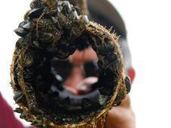
For the first time, zebra mussels have been documented in the Brazos River Basin in Lake Belton, an infestation nearly 200 miles south of where zebra mussels were previously found in Texas. This means that lakes in Central Texas are at even greater risk of infestation.
“The Lake Belton discovery underscores how critical it is for boaters all across Texas to get informed and involved to help stop the spread of zebra mussels,” said Brian Van Zee, TPWD Inland Fisheries regional director based in Waco. “Unfortunately, zebra mussel larvae, called veligers, are not visible to the naked eye. You could be transporting them on your boat and not even know it. This is why it’s particularly important to always Clean, Drain, and Dry your boat and gear before heading to another water body.”
As a result of this recent discovery, Lakes Belton and Stillhouse Hollow, and portions of the Leon and Lampasas rivers have been added to an emergency rule and are now under special regulation. Boaters who drain their boats and gear will not be considered in violation of rules prohibiting possession of zebra mussels. Read the full story of the discovery.
New rules are also in the works to fight zebra mussels. Under these proposed rules, boats operating on public water in 17 Northeast Texas counties will be required to be drained after use. This would apply to all types and sizes of boats, whether powered or not, personal watercraft, sailboats, or any other vessel used to travel on public waters in these counties: Collin, Cooke, Dallas, Denton, Fannin, Grayson, Hood, Jack, Kaufman, Montague, Palo Pinto, Parker, Rockwall, Stephens, Tarrant, Wise, and Young.
The public can comment on the proposed rules through 5:00 p.m. on November 6. The Texas Parks and Wildlife Commission is expected to take action on the proposed change at is November 7 meeting.
|
Back to Top


Some folks live for Texas trout season, but don’t let the anticipation make you crazy. Use the time to brush up on how to catch ’em: read about reels, hooks, bait, bobbers and get more angling tips from the TPWD Fisheries Biologist Marcos De Jesus. See where trout were stocked last year and bookmark this page for mid-November news of the 2013 winter stocking schedule. Some perennially popular stocking locations are the 15 Neighborhood Fishin’ Lakes.
Each year, about 40 million fish are added to public lakes, ponds, and saltwater bays by the Inland and Coastal Fisheries divisions of Texas Parks and Wildlife Department. Many of these fish are produced in the state's three saltwater and five freshwater hatcheries. Use these pages to find out what, where, and why we stock.
|
Back to Top
 Do you know an individual or organization that has made a lasting contribution to freshwater fishing in Texas? You have until December 31 to submit nominations for Texas Freshwater Fishing Hall of Fame. Do you know an individual or organization that has made a lasting contribution to freshwater fishing in Texas? You have until December 31 to submit nominations for Texas Freshwater Fishing Hall of Fame.
Nominations may be made in the categories of industry, angler or media. The nominee must be a Texan or Texas organization. Individuals may be either living or deceased. Selection will be made by an independent committee, and the induction will take place during the annual Hall of Fame banquet at the Texas Freshwater Fisheries Center in Athens the first Saturday in June.
See if someone you know is a previous winner.
The nomination forms and instructions are available on the Texas Parks and Wildlife Department web site or by calling (903) 670-2255.
Image: Lonnie Stanley (and Tommy Martin, not pictured) were inducted into the Texas Freshwater Fishing Hall of Fame in Athens on June 2, 2012.
|
Back to Top
A message from a Texas Parks & Wildlife magazine advertiser

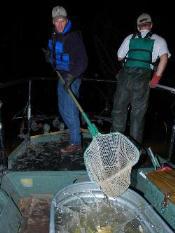
When you are on your favorite lake during the next few months, you may encounter a Texas Parks and Wildlife Department Inland Fisheries crew conducting one of several kinds of surveys, including a creel survey. Not all lakes are surveyed every year, but chances are good that a TPWD boat you see on a lake this fall and winter will carry a fisheries biologist working to make fishing better. Your cooperation if requested could improve your fishing future. Read the full story about the work biologists are doing on the water this fall.
The goal of all this activity is to make sound management decisions based on the best data available. Many times anglers ask, Why not stock (kind of fish) into (name of reservoir)? The answer may be that the reservoir does not contain habitat suitable for that species of fish. Or it may be that survey data show that fish of that species already in the reservoir are growing at less than a desirable rate, which may indicate there is not enough forage in the reservoir to support more fish. On the other hand, survey data may show that a reservoir has a forage base capable of supporting a different sportfish, in which case biologists may recommend stocking that species.
|
Back to Top
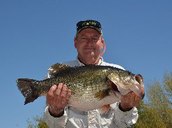
Most anglers don’t expect to catch a 13-pound bass and are not prepared to deal with it. This list of 13 steps tells you how to be as prepared as a Boy Scout.
Check this map to see what Texas water bodies have produced lunkers.
Watch this video about what happens to your special catch if you choose to donate it to Texas Parks and Wildlife as part of the Toyota ShareLunker program.
Remember any trophy bass deserves R-E-S-P-E-C-T from you and your fishing buddies while waiting for the TPWD Bass-mobile.
|
Back to Top
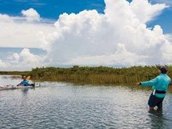
Can the boater, birder, kayaker, wade fisherman and air boat operator be friends? They share a use and love of coastal estuaries, but living and fishing in harmony can be challenging. Read what some boaters and kayakers learned about each other in “A Bay for All Seasons” from the Outdoor Annual.
- "Giving a kayaker a wide berth is not a problem,” says one fifth generation duck hunter who uses air boats during duck hunting months. “It is the ones that we don’t see until the last second that are dangerous for both parties.” He adds, “Airboats have no reverse or brakes, so trying to prevent a last-minute collision is usually impossible.”
- A kayak angler for over 15 years says boaters still do not know what to do when they encounter a kayak. Once a passing boater slowed down abruptly to pass him, unknowingly creating a bigger, bulging wake he had to overcome. Had the boat continued with just a little more separation, both could have shared the channel comfortably.
- Another kayak and boat angler understands the need to not damage the seagrass. Seeing the grass from kayak level, he gets it: “No grass, no fish.”
Be mindful of what your impact will be on other anglers and the environment. If the impact is adverse, adapt using a different method or tactic.
|
Back to Top
A message from a Texas Parks & Wildlife Magazine advertiser

 Saltwater anglers and divers will be happy to know that nearshore artificial reef sites continue to grow with the recent addition of approved reefing material as part of the Artificial Reef Program. Saltwater anglers and divers will be happy to know that nearshore artificial reef sites continue to grow with the recent addition of approved reefing material as part of the Artificial Reef Program.
Sabine Artificial Reef (HI-117), about 21 nautical miles offshore of Sabine Pass, grew with the addition of more than 100 1-ton quarry rocks, delivered by RL Eldridge Construction Inc. Watch a video of the big barge-crane-rock action.
At the Corpus Christi Nearshore Reef Site (MU-775), concrete culverts and pyramids were deployed at the center of the reef site this past summer.
Artificial reefs provide habitat for invertebrate species that feed snapper, grouper, mackerel, shark and other fish. These hotbeds of wildlife are destinations for anglers and divers and benefit local coastal economies as well. Follow Texas’ Artificial Reefs on Facebook and head on out there.
|
Back to Top



|